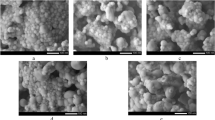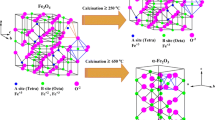Summary
Room temperature Mössbauer spectrum of fly ash-recycled glass (FARG), prepared with more than 86 mass% of fly ash and less than 14 mass% of Fe2O3, comprises two types of doublets due to Fe(II) and Fe(III) of magnetite nanoparticles. Isothermal annealing of fly ash-recycled glass at 1100 °C for 60 minutes results in a precipitation of ferrimagnetic magnetite phase having an internal magnetic field of 46.4-48.2 T. When the Fe2O3 content is equal to or more than 14%, room temperature Mössbauer spectrum of FARG shows a magnetic hyperfine structure due to a magnetite phase, in addition to two doublets due to Fe(II) and Fe(III). An increase in the electric conductivity is observed from the order of 10-8 to 10-6 S . cm-1 after heat treatment at around the crystallization temperature. This can be ascribed to an improved step-by-step electron hopping from Fe(II) to Fe(III) of distorted FeO4 tetrahedra in the three-dimensional glass network.
Similar content being viewed by others
Author information
Authors and Affiliations
Rights and permissions
About this article
Cite this article
Nishida, T., Tokunaga, M., Sugata, Y. et al. Mössbauer study of semiconducting and ferrimagnetic fly ash-recycled glass. J Radioanal Nucl Chem 266, 171–177 (2005). https://doi.org/10.1007/s10967-005-0889-0
Issue Date:
DOI: https://doi.org/10.1007/s10967-005-0889-0




